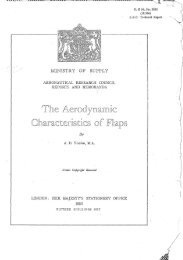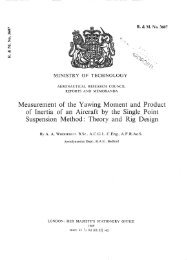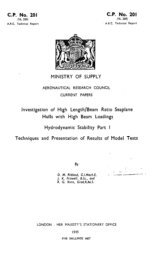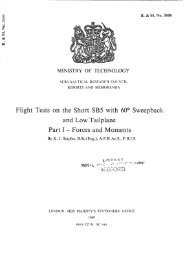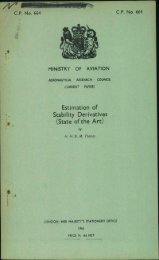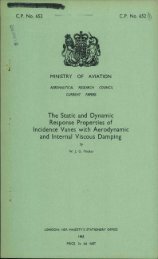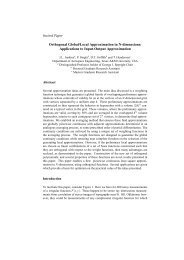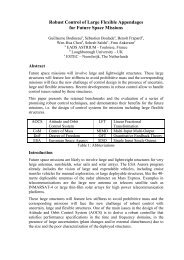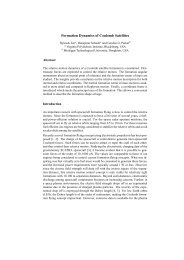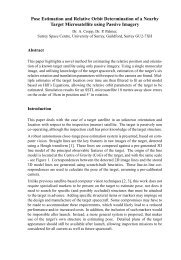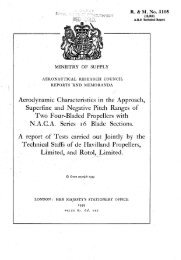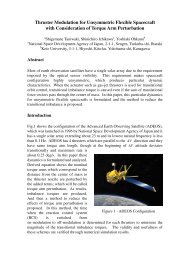The Prediction of Helicopter Rotor Hover Performance using a ...
The Prediction of Helicopter Rotor Hover Performance using a ...
The Prediction of Helicopter Rotor Hover Performance using a ...
You also want an ePaper? Increase the reach of your titles
YUMPU automatically turns print PDFs into web optimized ePapers that Google loves.
1 INTRODUCTION<br />
<strong>The</strong> modern turbine powered helicopter is more <strong>of</strong>ten limited by the thrust<br />
capability <strong>of</strong> the main or tail rotor than by a lack <strong>of</strong> available power. This<br />
limitation in forward flight is due to the blade stalling on the retreating side<br />
<strong>of</strong> the rotor disc, and is the reason for the growing trend towards aer<strong>of</strong>oil<br />
sections designed specifically for helicopter rotors instead <strong>of</strong> the NACA 00<br />
series aer<strong>of</strong>oils which have been used for so long. However, the potential bene<br />
fits <strong>of</strong> <strong>using</strong> new blade pr<strong>of</strong>iles, or making other changes to the rotor geometry,<br />
can only be exploited effectively if the blade load distribution can be<br />
accurately calculated in all flight conditions.<br />
<strong>The</strong> ideal blade geometry for high speed forward flight is unlikely to be<br />
ideal for efficient hover and the designer must reach a compromise solution.<br />
<strong>The</strong> final configuration will be achieved by giving different weightings to<br />
hover performance according to the tasks which the particular helicopter is<br />
expected to perform. A heavy lift, or crane helicopter, is likely to have its<br />
forward speed capability sacrificed for a more efficient hovering performance.<br />
An aer<strong>of</strong>oil section with a high usable lift coefficient at a Mach number <strong>of</strong> 0.6,<br />
a typical value for the blade tip in hover, would undoubtably be advantageous,<br />
but such an aer<strong>of</strong>oil is likely to have a low drag rise Mach number and shock<br />
induced separations would limit the Mach number <strong>of</strong> the advancing blade and hence<br />
the forward speed capability <strong>of</strong> the aircraft. In addition, the best twist<br />
distribution for hover is likely to be too large for high speed forward flight.<br />
However, the essence <strong>of</strong> the helicopter concept is its high efficiency as a<br />
hovering vehicle and a method <strong>of</strong> predicting the hover performance <strong>of</strong> a whole<br />
range <strong>of</strong> blade geometries and rotor configurations is essential.<br />
<strong>The</strong> main problem in calculating the performance <strong>of</strong> a helicopter in hover<br />
is determining the induced flow velocity through the rotor. <strong>The</strong> simplest mathe<br />
matical model <strong>of</strong> a rotor is the actuator disc in which the rotor is replaced by<br />
a disc having a pressure difference between the upper and lower surfaces. This<br />
concept can be used for forward flight or hover calculations but suffers from<br />
the disadvantage that the effect <strong>of</strong> changing the rotor parameters such as blade<br />
geometry, aer<strong>of</strong>oil section, solidity and tip speed cannot be investigated.<br />
An improved model <strong>of</strong> the flow combines blade element and momentum theory.<br />
<strong>The</strong> radial variation <strong>of</strong> the induced velocity and hence the forces on the blade<br />
are better represented in this model making it suitable for initial design



